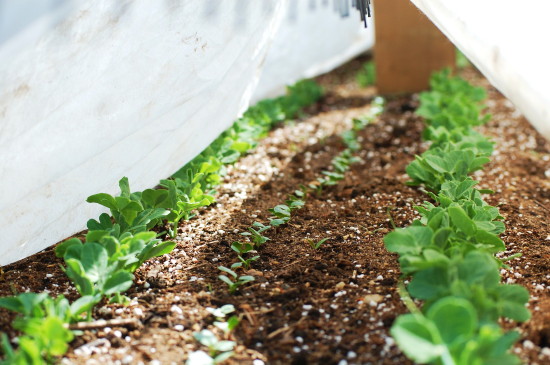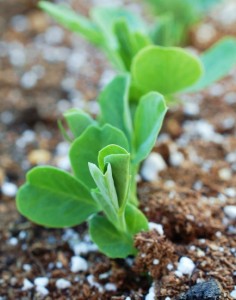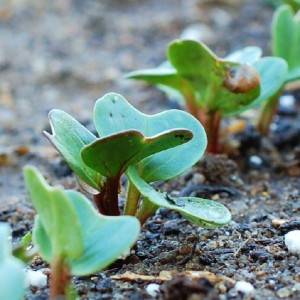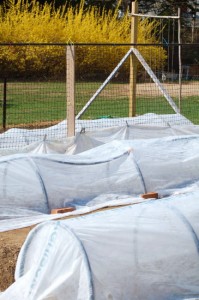
 The garden looks like a morgue right now, I’m sorry to say. It’s not that anything’s dead—yet. (And I hope it stays that way, though we are really pushing things this year.) It’s just that most everything we’ve planted is under row cover, for one reason or another, and the billowy white fabric sort of looks like sheets over, well, you get the picture.
The garden looks like a morgue right now, I’m sorry to say. It’s not that anything’s dead—yet. (And I hope it stays that way, though we are really pushing things this year.) It’s just that most everything we’ve planted is under row cover, for one reason or another, and the billowy white fabric sort of looks like sheets over, well, you get the picture.
 It doesn’t help that all the pretty stuff is hidden. At least a couple times a day I have to go peek—usually at the peas, which I find unbearably beautiful and promising as they unfurl their wings. (Plus, I am very proud of how well they germinated and the fact that I’ve managed to get radishes and lettuce into this raised bed, too. So I just have to stare at it all, you know.) I also have to remove the covers to water, but then I tuck everything back in, using clothespins, fabric pins, bricks, rocks—a motley assortment of things to keep the fabric down while the fierce Vineyard wind tries mightily to rip it off.
It doesn’t help that all the pretty stuff is hidden. At least a couple times a day I have to go peek—usually at the peas, which I find unbearably beautiful and promising as they unfurl their wings. (Plus, I am very proud of how well they germinated and the fact that I’ve managed to get radishes and lettuce into this raised bed, too. So I just have to stare at it all, you know.) I also have to remove the covers to water, but then I tuck everything back in, using clothespins, fabric pins, bricks, rocks—a motley assortment of things to keep the fabric down while the fierce Vineyard wind tries mightily to rip it off.
I had to laugh, because one of my favorite garden bloggers (and another former magazine editor), Margaret Roach, posted about row cover this past week, too. Read her informative interview with Paul Gallione of Johnny’s Seeds to learn some different uses for row cover. I also discovered, when I went looking for a “proper” definition of row cover (“sponbonded polyester” is it), an earnest blog site, Whiz Bang Row Cover Hoop System, which goes into great detail about hoop-supported row cover.
We are not quite so technical. We order our medium-weight row cover (Agribon 19) from Johnny’s Seeds or FedCo in big rolls. Then we go to the plumbing supply store and buy 50 or 100 feet of 3/4-inch PVC pipe and cut it into the right lengths using a ratchet cutter like this. Because we splurged on new fabric this spring (our old stuff has a lot of holes in it—fine for wind and some cold protection, but not for pest protection), I am using mostly bricks and stones to hold down the new fabric right now. The fabric pins are more secure, but you have to be careful about poking so many holes in the fabric, which then let tiny bugs in.
 That brings me around to the main reasons we use row cover: wind, cold, and bugs. The bugs actually came first. I experimented with row cover our first season to keep flea beetles and cabbage worms from decimating all the brassica crops—especially my greens like mizuna, bok choy and kale. It worked well as long as I kept the row cover in good shape and securely on most of the time. Last year I wasn’t so diligent, and I paid the price. I never covered the kale at all, and I had some very beautiful Brussels Sprouts stalks until I took the row cover off of them in late August after the storm. A few weeks later, not having paid close attention, I realized the cabbage worms had settled in for a feast.
That brings me around to the main reasons we use row cover: wind, cold, and bugs. The bugs actually came first. I experimented with row cover our first season to keep flea beetles and cabbage worms from decimating all the brassica crops—especially my greens like mizuna, bok choy and kale. It worked well as long as I kept the row cover in good shape and securely on most of the time. Last year I wasn’t so diligent, and I paid the price. I never covered the kale at all, and I had some very beautiful Brussels Sprouts stalks until I took the row cover off of them in late August after the storm. A few weeks later, not having paid close attention, I realized the cabbage worms had settled in for a feast.
 I’ve also used row cover over newly planted carrot seeds in the past, so I am trying that again this year, only earlier. Theoretically the cover keeps a downpour from washing the tiny carrot seeds away. But we’ve hardly had a shower, much less a downpour, all spring so this may be a mute point.
I’ve also used row cover over newly planted carrot seeds in the past, so I am trying that again this year, only earlier. Theoretically the cover keeps a downpour from washing the tiny carrot seeds away. But we’ve hardly had a shower, much less a downpour, all spring so this may be a mute point.
But the main reason we are using so much row cover this spring is to protect newly transplanted lettuce and greens from wind and cold. The medium-weight row cover only offers a few degrees of warmth, but it makes a difference while the roots are struggling to establish themselves. And protecting them from the dry wind we’ve been having is huge. The wind not only breaks the fragile seedling stems, but it also dries the soil out very quickly. And since the soil is so dry anyway, I’d like the little bit of water I’m adding not to evaporate more quickly than it has to.
 Lastly, the reason the peas are under cover is crows (and other birds). Newly germinating peas are delicious bird snacks, so until the peas get tall enough to start clinging on to the mesh we’ve hung for them, they’ll be under cover. Peas love cool weather so they don’t need heat protection, but they appreciate the tiny microclimate under the row cover anyway. And the radishes and lettuce next to them are especially happy. The row cover on the pea bed is a real pain in the neck though. Because the trellis runs down the middle of the bed, hoops are not an option. Instead we wrap the row cover all the way around the raised bed like swaddling and then hold the middle up above the peas by clipping it to the trellis mesh with clothespins.
Lastly, the reason the peas are under cover is crows (and other birds). Newly germinating peas are delicious bird snacks, so until the peas get tall enough to start clinging on to the mesh we’ve hung for them, they’ll be under cover. Peas love cool weather so they don’t need heat protection, but they appreciate the tiny microclimate under the row cover anyway. And the radishes and lettuce next to them are especially happy. The row cover on the pea bed is a real pain in the neck though. Because the trellis runs down the middle of the bed, hoops are not an option. Instead we wrap the row cover all the way around the raised bed like swaddling and then hold the middle up above the peas by clipping it to the trellis mesh with clothespins.
Is all this worth it? Well, considering we have hundreds (maybe thousands) of seedlings out there right now, I hope so. The goal is a nice harvest of greens to open the farm stand with on Memorial Day. So we’ll keep you posted—there are any number of hurdles (or hoops) to jump through (or over) before we get there!

there was an interesting story on NPR yesterday about a guy who saves/collects heirloom seeds in Maine. You should check it out!
Wish I could come by your farmstand on Memorial Day,